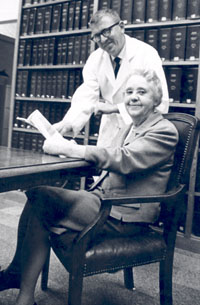Biographies
John M. Kissane Memorial to Margaret Gladys Smith
John M. Kissane, a professor in both the Departments of Pathology and Pediatrics of the Washington University School of Medicine, wrote this eulogy for his colleague and friend, Margaret G. Smith. Kissane, a 1952 graduate of the Washington University School of Medicine, joined the faculty of his alma mater in 1958 as an instructor in the Department of Pathology. Smith and Kissane co-authored the 1967 reference book Pathology of Infancy and Childhood. Smith died after a heart attack in the spring of 1970.
 |
| John M. Kissane and Margaret G. Smith, ca. 1967 |
Each of us in this gathering knew Dr. Margaret Smith and has his own personal memories of her. Extended reminiscences or a recital of biographic detail would be superfluous indeed before this group. It is appropriate, however, for us on this occasion to pause and reflect on the quality of this life which touched us all.
In reflecting on a life as long as Dr. Smith’s, it is customary to cite historic associations, venerable traditions, or links with the past embodied in that life. In speaking of Dr. Smith, however, it is more appropriate to describe transitions which her career spanned, for she made transitions gracefully.
She who could not because of her sex, vote in a national election when she attained the majority, lived to concern herself in and participate in local, state, and national public affairs. A graduate of the Johns Hopkins University School of Medicine in a day when a woman was a rarity in a learned profession, she lived to have her voice heard and counsel sought by leaders in her profession. When she began her investigative career, viruses were a hypothesis, or at most a deduced intellectual prediction. In Dr. Smith’s lifetime, viruses assumed the physical reality of an ultra-structure, metabolic turnover, and acquisition of a capsule.
An aspect of Dr. Smith’s personality, perhaps inapparent to casual acquaintances, was its wholeness. Seeing only the working hours which would break a man half her age, casual acquaintances too easily voiced the simplification, “The department is her home, and her associates are her family.” These things are true, but they are not the whole truth.
With no immediate family of her own, Dr. Smith concerned herself with her relative’s children. A representative of that real family is with us today.
During most of her life, Dr. Smith spent fourteen hours a day in the medical center. But besides this figurative home, she had indeed a real home – a lovely and highly personalized one of which she was very proud and in which she delighted to welcome her friends.
She took two-thirds of her meals in the hospital, but Dr. Smith knew and appreciated good food, good company, and good conversation. Engaged in a field peopled largely by men, she could converse knowledgeably, and in appropriate vernacular, about professional sport, and yet not lose her patrician femininity.
Now finally, we should interpret, in the present context, a series of terms customarily applied in circumstances such as this. We who remain feel sorrow, but it is not the sorrow witnessing a decline of faculties or prolonged incapacity. We know grief, but it is not the grief of seeing physical pain or suffering. We sense loss, but it is a loss from fullness rather than the loss which results from work undone. And so each of us must, in his own way, and husbanding his own memories, take his leave of one who was variously our teacher, our preceptor, and our dear friend.
Related Links:
Return to WUMC Faculty/Staff (Biographies)
Return to All Biographies
Back to Top
